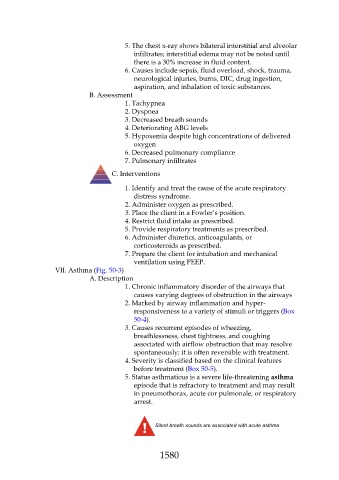Page 1580 - Saunders Comprehensive Review For NCLEX-RN
P. 1580
5. The chest x-ray shows bilateral interstitial and alveolar
infiltrates; interstitial edema may not be noted until
there is a 30% increase in fluid content.
6. Causes include sepsis, fluid overload, shock, trauma,
neurological injuries, burns, DIC, drug ingestion,
aspiration, and inhalation of toxic substances.
B. Assessment
1. Tachypnea
2. Dyspnea
3. Decreased breath sounds
4. Deteriorating ABG levels
5. Hypoxemia despite high concentrations of delivered
oxygen
6. Decreased pulmonary compliance
7. Pulmonary infiltrates
C. Interventions
1. Identify and treat the cause of the acute respiratory
distress syndrome.
2. Administer oxygen as prescribed.
3. Place the client in a Fowler’s position.
4. Restrict fluid intake as prescribed.
5. Provide respiratory treatments as prescribed.
6. Administer diuretics, anticoagulants, or
corticosteroids as prescribed.
7. Prepare the client for intubation and mechanical
ventilation using PEEP.
VII. Asthma (Fig. 50-3)
A. Description
1. Chronic inflammatory disorder of the airways that
causes varying degrees of obstruction in the airways
2. Marked by airway inflammation and hyper-
responsiveness to a variety of stimuli or triggers (Box
50-4).
3. Causes recurrent episodes of wheezing,
breathlessness, chest tightness, and coughing
associated with airflow obstruction that may resolve
spontaneously; it is often reversible with treatment.
4. Severity is classified based on the clinical features
before treatment (Box 50-5).
5. Status asthmaticus is a severe life-threatening asthma
episode that is refractory to treatment and may result
in pneumothorax, acute cor pulmonale, or respiratory
arrest.
Silent breath sounds are associated with acute asthma
1580

